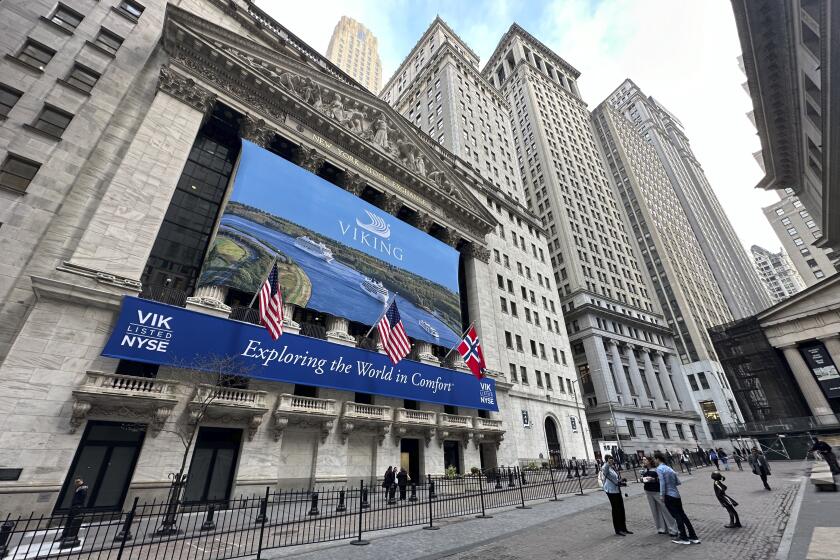You Can Still Take It to the Bank
A top banking executive, recalling the near disaster of his industry, asked recently, “Does anybody know how close the U.S. banking system came to collapsing like the savings and loans?”
The answer is that most people would rather forget the bad days of 1990-91 when insolvency threatened major banks and Alan Greenspan, chairman of the Federal Reserve Board, warned that the banking industry was at its weakest point since the Civil War.
It was taken for granted that the U.S. commercial banking system, with $3 trillion in assets, would never be the same. Experts predicted that the country’s 12,000 banks at that time would dwindle to five giant institutions, following the banking pattern in Canada and Britain.
Other experts said banks couldn’t compete with financial service companies, such as the brokerage giant Merrill Lynch, and would fade away because they would no longer be needed.
But the crisis demonstrated that a healthy banking system is essential to a healthy economy. Banks were saved and are vibrant today. Their recovery stands as a great example of government and business working together to save an essential industry.
With the aid of the Federal Reserve, the Controller of the Currency and the Federal Deposit Insurance Corp., banks five years ago wrote off bad real estate loans and repaired their balance sheets, not by making new loans but by investing in government securities.
There was a cost. Small businesses couldn’t get credit, and that made the recession worse.
But today all is different. Banking is an industry with a bright future in the big world of financial services: Giant banks will occupy a key position, and at the local level, small banks will play a vital role.
There are still 9,841 banks in the United States, and though the number is shrinking, there probably will always be 6,000 or more banks because they can serve as conduits for productive investments in all communities.
Their mortgage loans, and those of the remaining S&Ls;, can help families own houses, possibly lifting home ownership in poor neighborhoods from today’s levels of 35% to 45% toward the national average of more than 60%. Home ownership builds family equity, which can be the cornerstone of small business and job creation.
Better than welfare, in a word. As the federal government turns welfare over to local control, new needs and problems will arise--and banks can be part of the solution.
As they already are. Eugene Ludwig, the U.S. controller of the currency--chief of the nation’s bank examiners--noted last week that $100 billion in new mortgage loans have been made in distressed minority neighborhoods in the last three years.
“I took the Community Reinvestment Act [a 1977 law requiring banks to lend in poor as well as affluent parts of their territories] and said to the banks, ‘Let’s see performance--let’s see loans,’ ” Ludwig declared.
It was a campaign year boast, but it made a point. Ludwig was in Los Angeles late last week to take part in the annual Bankers Bus Tour, in which several hundred bankers, bank regulators and community officials ride through areas burned or otherwise damaged in the 1992 riots.
The idea, originated by Operation Hope, a community organization, is to acquaint bankers with neighborhoods they seldom drive through and with opportunities to fulfill their Community Reinvestment Act responsibilities to make loans.
And they’re making them. Since 1992, $1.3 billion in mortgage loans has been made in central Los Angeles, a complex of affluent as well as poor neighborhoods where, despite their reputation, house-proud streets are the norm, not the exception.
For the commercial streets, which vary from vibrant to shuttered, $400 million in new loans to small businesses has been made in the last four years. The loans are 80%-guaranteed by the federal Small Business Administration, so the banks’ risk is not great.
But the impact of their loans can be. The bankers this year noted “more fresh coats of paint,” as one put it.
Carlton Jenkins, chairman of Founders National Bank, pointed to a new shopping center and senior citizen complex that his bank helped finance. William Hanna, president of Cedars Bank, noted several supermarkets that opened with loans from his bank.
Loans for $198,000 to a funeral home for expansion and $400,000 to a successful restaurant to open a second site were handed over in public ceremonies. Wilshire State Bank in Koreatown led groups of lenders in making those loans.
The loans are not handout money but pump-priming capital. Local churches often participate as co-lenders. The programs, in fact, represent a combined effort of law and government and entrepreneurship and energy. And we’ll see more of them because, again, they’re better than welfare.
Meanwhile, if banks get a break on lending in poor areas, banking is not a protected industry. On the contrary, it’s intensely competitive these days. The giants being created by mergers such as NationsBank-Boatmen’s or Wells Fargo-First Interstate are not lumbering dinosaurs but institutions capable of using computing power to lower costs and make loans at lower interest rates.
That’s why giant banks make most of the loans to small business. The small banks prosper on the leftovers, which are considerable enough. Anticipated in the Wells Fargo-First Interstate merger was the loss of $100 million in business to smaller competitors.
Motivating the mergers, however, is not a desire for more lending but an increased presence in financial services. Experts who once predicted that banks would lose out to brokerage companies now see them succeeding as distributors of mutual funds, insurance and investments for America’s aging millions.
This time the experts are right. One of the most successful banks in the country, Norwest Corp. of Minneapolis, is already growing not by merger but by selling annuities, mutual funds and other financial instruments.
Next year Congress will probably repeal legislation dating to the 1930s that has kept banks out of the investment securities business, says banking consultant Michael Morrow. “Banks are the way Fidelity can compete with Merrill Lynch,” he says.
So banking grows and prospers and provides essential services. At a time when we hear slogans about government or about free enterprise, we should keep in mind that the two are most effective when working together.






